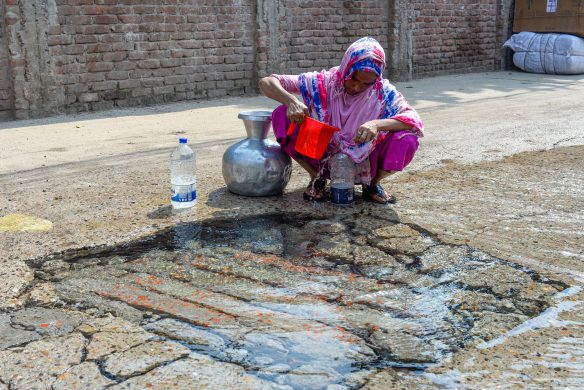In Mexico on December 20, 2017, Economic Commission for Latin America and the Caribbean (ECLAC) launched its report Social Panorama 2017, which includes an update to the methodology used to estimate monetary poverty in the region.
A press release from ECLAC states:
Poverty and extreme poverty levels rose in Latin America as a regional average in 2015 and 2016, after more than a decade of declines in the majority of countries, while in 2017 they are expected to hold steady, the Economic Commission for Latin America and the Caribbean (ECLAC) said today.
In 2014, 28.5% of the region’s population was in situations of poverty (168 million people), a percentage that increased to 29.8% in 2015 (178 million) and to 30.7% in 2016 (186 million people). Extreme poverty, meanwhile, rose from 8.2% in 2014 (48 million people) to 10% in 2016 (61 million people).
Fattigdommen og uligheden er faldet i perioden 2002 – 2016
Despite these figures, a medium-term perspective leads to a positive balance overall in terms of poverty reduction, since it shrank by 15.2 percentage points between 2002 and 2016, according to the report Social Panorama of Latin America 2017, presented this Wednesday by Alicia Bárcena, ECLAC’s Executive Secretary, at a press conference in the organization’s offices in Mexico City.
Income inequality also decreased between 2002 and 2016, although the pace of the decline has slowed in recent years. The Gini coefficient (where 0 represents no inequality and 1 maximum inequality) went from 0.538 in 2002 to 0.467 in 2016.
“Recent experience indicates that the rise in income among households with the fewest resources has been indispensable to reducing both poverty and income inequality. And this growth has clearly been fostered by countries’ distributive and redistributive policies, such as tax reforms, minimum wages, pensions and transfers linked to poverty reduction strategies and to the expansion of social protection systems,” Bárcena said.
For that reason, “a call must be made to strengthen labor and social protection policies, even more so in periods of low economic growth, and to implement the 2030 Agenda for Sustainable Development based on progressive structural change,” the senior United Nations official added. She clarified that, due to the updated methodology used to estimate poverty by income in the region, the values included in the report update the figures presented in previous editions (from 2002 to the present) in order to have a comparable analysis of the phenomenon in the long term, as ECLAC has traditionally done.
Next year, Bárcena said, a detailed report on that methodology will be published along with the country figures, once technical consultations have concluded.
Børn, unge kvinde og befolkningen på landet mest udsat for fattigdom
The Social Panorama of Latin America 2017 shows that poverty and extreme poverty rates are higher among children, adolescents, young people, women and the population residing in rural areas. In 2016, poverty affected 46.7% of children and adolescents between 0 and 14 years of age and extreme poverty, 17%. In the case of young people from 15 to 29, these figures were 31.1% and 9.5%, respectively.
The report published today by ECLAC also analyzes the evolution and challenges of pension systems, which are fundamental for guaranteeing the rights to social security and social protection in the region in a context of accelerated demographic change. It is estimated that by 2040, people 60 years and older will exceed the number of people from 0 to 14, and that the population 80 years and older will increase by nearly 20 million. There is also a trend being observed toward the feminization of the older adult population.
Flere indbetaler til pensionsordninger
According to the document, between 2000 and 2014 the contributory base of pension systems in Latin America expanded: the percentage of the economically active population that contributes to a pension system went from 36.9% to 47.8%. This is equivalent to the incorporation of nearly 60 million people to the contributory systems and is associated with the positive evolution of labor markets in that period (especially with the decline in unemployment and increased levels of employment, formalization and labor income), as well as with the implementation of strategies to expand coverage of social security systems in some countries.
Despite this, it is estimated that 142 million economically active people are still not covered. The proportion of workers that remain unprotected is higher in rural areas, among people with less schooling, and in sectors with lower productivity.
Between 2002 and 2015, the percentage of Latin America’s population 65 years and older that received some kind of pension (both contributory and non-contributory) also increased, rising from 53.6% to 70.8%. Coverage grew considerably in the lower-income group (30 percentage points) and in rural areas (33 percentage points), which can be explained primarily by the expansion of non-contributory pensions, the coverage of which increased 20 percentage points between 2000 and 2015. Despite this progress, 29% of the population 65 and older did not receive any kind of pension in 2015.
In addition, major challenges persist in terms of the sufficiency of the benefits received.
Although the average pension amount rose at an average annual rate of 2.1% between 2002 and 2015, in this last year 36% of pension beneficiaries received amounts that were equal to or below two poverty lines, the organization warns.
Mindre pension til kvinder
In nearly all the countries, women of retirement age have lower levels of coverage in the pension systems, and the gaps in the amount of benefits they receive exceed 20 percentage points in 10 of the 17 countries analyzed, reaching as much as 40 percentage points.
“The design of pension systems is key to gender equality,” the regional organization sustains, given that currently more than half of all employed Latin American women work in low productivity sectors, and only 1 in every 5 of them are affiliated or contribute.
According to the study, 11 Latin American countries carried out structural reforms to their pension systems between 1981 and 2008. The result was the creation of four models, which substituted or complemented the traditional system of distribution through individual capitalization.
Meanwhile, the 14 parametric reforms and 3 structural reforms implemented between 2008 and 2017 demonstrate a new trend, with a common denominator: they advance on the development of mechanisms of solidarity and the majority of them increase the participation of the State, both in the administration and financing of the systems. The greatest challenge, ECLAC indicates, is to strike a balance between adequate coverage, sufficient benefits and financial sustainability.
The study concludes by affirming that the consolidation of universal, caring and sustainable pension systems is a possible and necessary objective in a social compact for development with equality.















